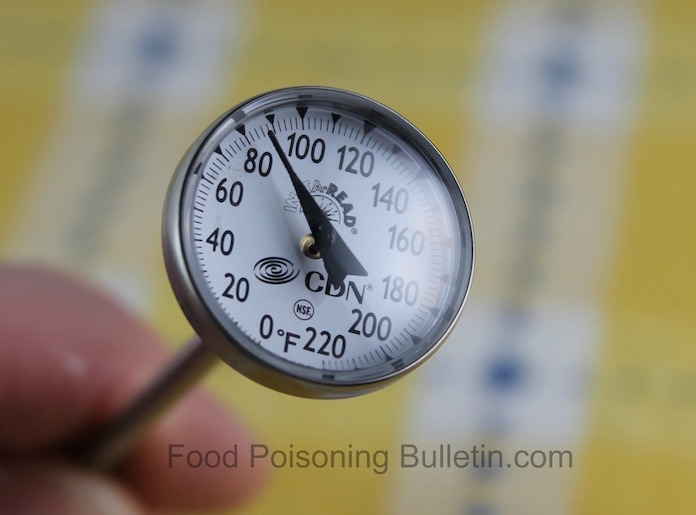As part of our series on helping beginning cooks learn about food safety during the coronavirus pandemic, the safe minimum cooking temperatures for many foods is critical. These risky foods have to be handled carefully and cooked thoroughly to avoid the risk of a serious foodborne illness.

These foods include beef, pork, seafood, chicken, turkey, shellfish, and foods made with eggs. All of these foods have been linked to multistate food poisoning outbreaks in the past. When you handle these foods, make sure to avoid cross-contamination between them and foods that are eaten uncooked. Meat juices dripping on other foods in the fridge is a main source of contamination.
Safe Minimum Cooking Temperatures
First of all, the only way to tell if these foods are safe to eat is by using an accurate and reliable food thermometer. All of the temperatures below are of the food. Insert the thermometer probe about 1-inch into the meat and wait until the dial or digital readout stops moving.
For beef, whole cuts such as steaks, roasts, and chops should be cooked to 145°F and then given a 3 minute rest time so the juices can redistribute and the temp rise slightly. Ground beef should always be cooked to 160°F; underdone hamburgers are not safe to eat.
For poultry, all poultry, including breasts, the whole bird, legs, thighs, and wings, should be cooked to 165°F. Ground chicken and turkey should also be cooked to 165°F. If you stuff a chicken or turkey, the stuffing should also reach 165°F. And giblets, including chicken liver, should be cooked to 165°F. Pink chicken livers, especially if used to make pate, are not safe.
For pork, including fresh ham, all types of roasts, chops, and steaks should be cooked to 145°F with a 3 minute rest time. This temperature was lowered from 160°F by the USDA in 2011. Ground pork and sausage should be cooked to 160°F. If you reheat cooked ham, reheat to 165°F.
Eggs should be cooked until the yolks and whites are firm. Eggs cooked “easy” are not safe to eat. Egg dishes, such as omelets and quiches, should be cooked to 160°F.
Seafood has special cooking temperatures. All fin fish should be cooked to 145°F or until the flesh flakes when tested with a fork. Shrimp, lobster, scallops, and crab should be cooked until the flesh is pearly white and opaque. And clams, oysters, and mussels should be cooked until the shells open. (By the way, never cook shellfish that isn’t tightly closed when alive, and discard any shellfish that doesn’t open when cooked.)
Finally, leftovers such as casserole should be reheated to 165°F. That includes egg dishes and other recipes such as lasagna.





internal temp of 165 degrees ?? That’s confusing. Oven temp should be stated.
Good comment; I’ll clarify. No the internal temperature of 165°F is of the food. This can only be measured by using a food thermometer. You insert the probe into the food about 1″ deep and wait until the temperature gauge or dial stops moving. It doesn’t matter what the oven temperature is; the food will just take longer to get to that temp if the oven temperature is lower.